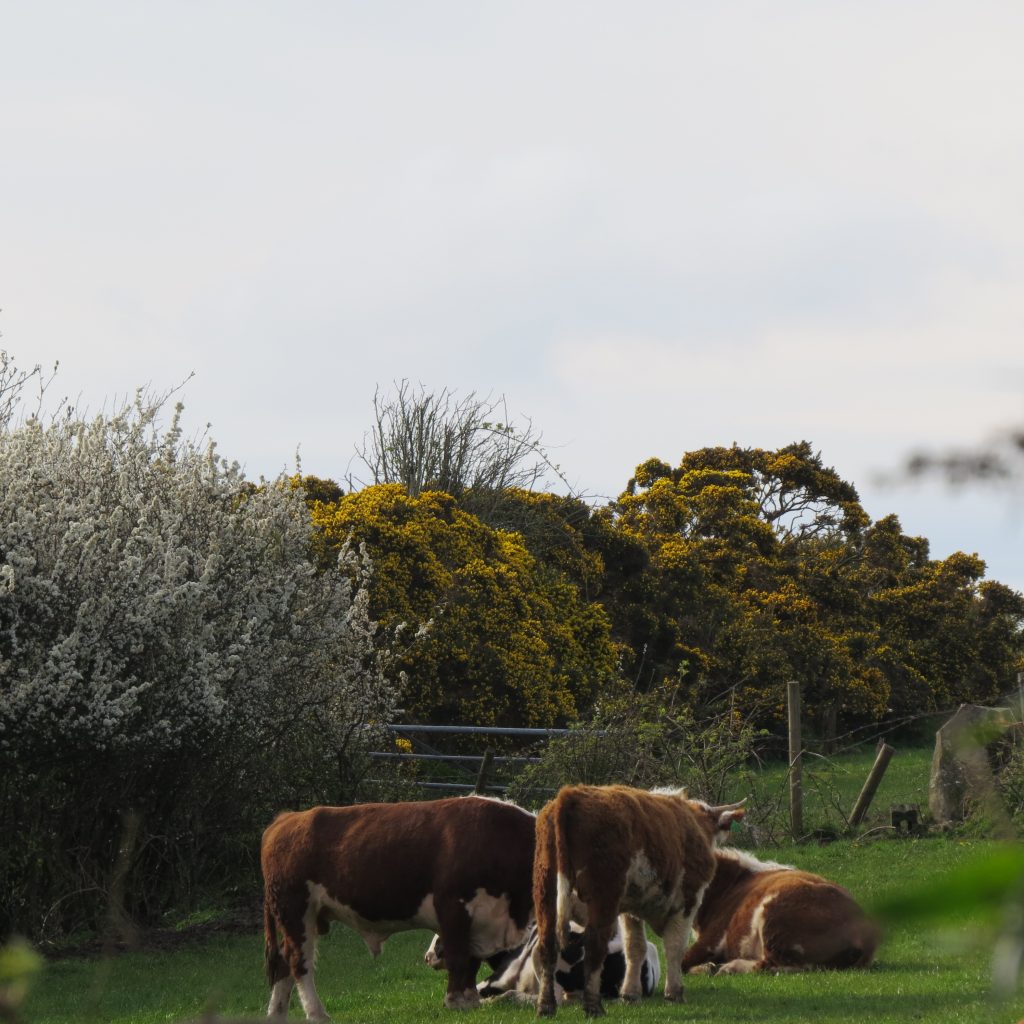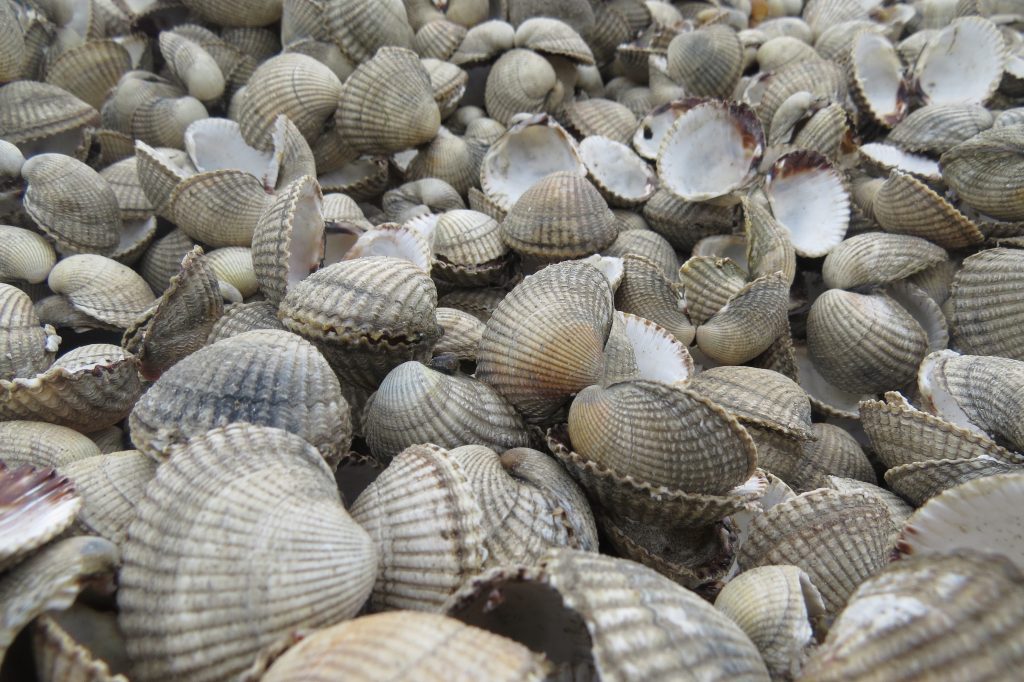This is from the introduction to my book, Welsh Food Stories:

“I am standing on a gusty, tussocky hilltop in mid-August. Streaks of sunlight reach me as the clouds, only a few dozen meters above my head, billow past. Every now and then, a few light drops of rain wet my cheeks. Behind, where the heather-brown hills rise yet higher, the clouds have run into each other and shed curtains of rain across the landscape. But before me and below me lies a green vale bathed in sunlight – here, out of the wind, a patchwork of small fields, ancient woodlands and hedgerows shelter solid, old farmhouses and fields of corn. And beyond this, the coastal lowland, beaches of holidaymakers and then the sea, shimmering in the sun.
This scene – from the Glamorgan ridgeway near Cardiff – could have been located in almost any part of Wales. On the Clwydian range of the north-east. Near Harlech, in the north-west. In the Preseli mountains of the south-west. Or where it did, on the Glamorgan ridgeway of the south-east. For unlike northern France, central England or northern Germany, all parts of northern Europe otherwise broadly comparable in latitude and climate to Wales where the same prevailing conditions and landforms continue for hundreds of miles, Wales is a world of microcosms.
Food history?
Welsh food has reflected this. Traditionally, the foods of Wales were marked by great variation. There were significant differences between the diets on the coasts and in the river valleys, where grain could be grown and most of the towns and all the ports were located, and the mountainous interior, with worse growing conditions and climate and so more dependence on hardy animals. Similarly, the differences between social classes were marked, during some periods even more than others. The landless peasant classes, particularly during times of crisis and famine, often suffered badly and their diet during these periods was pitiful. But society at all times also contained free farmers and smallholders, as well as wealthy and well-connected landowners, who had a more stable economic basis and had access to much more variety in food.
And so that simple, evocative phrase, ‘Welsh food’ is much more problematic than it sounds. Whose Welsh food – and where and when? The historiography of Welsh food, such as it is, has been dominated by accounts of working-class Victorian poverty, and rural hardship before then. The pastoral economy of upland, wild Wales has typically been regarded as providing the meanest of fare, with oats and diary predominating, and simple dishes cooked on backward implements. There is of course some truth in this. During the sixteenth century, for instance, the abject poor were estimated at 30% of the population, and they typically dwelt in one-roomed hovels lacking windows and chimneys. The basic component of the lowest class’s pre-twentieth century diet would have been oat gruel and dairy products or meat when they were available. Female members of this class in Anglesey were so well known for their persistent begging for cheese, butter and milk that they were known as gwragedd cawsa (cheese gatherers). But even for the lowest class the trope of Welsh poverty does not hold; during the era of the workhouse and the working poor, for instance, the British food enquiry of 1863 noted that the Welsh labouring classes were better fed than their English counterparts.
And a good proportion of the population from the sixteenth century onwards were small farmers and smallholders – usually around 50%. In favoured areas such as the Vale of Glamorgan, these could be relatively prosperous. And dairy, which many parts of Wales specialized in, could bring riches to less well-endowed regions too: by the 1540s, two Anglesey drovers, Rhys ap Cynfrig and Rhys ap Llywelyn, had grown rich exporting cattle to markets in the English midlands. These semi-independent farmers, although subject to times of crisis and famine too, generally had the resources to enjoy a varied diet, at least for most of the year. The earliest Welsh laws, attributed to the 9th century King, Hywel Dda, codify in great detail the value of different foodstuffs: honey, pigs, fruiting trees, sea-trout, all of which featured in Welsh diets of the time and later. The 12th century commentator, Gerald of Wales, notes how the typical Welsh diet of his day consisted primarily of nutrient-rich meat and dairy, in contrast to the grain- and gruel-eating lowland dwellers of England and France, precisely due to the upland nature of much of the country.

Above these classes were the members of the professions, merchants and wealthier craftsmen and yeomen, who constituted around 15% of the population. These dwelt on established farmholdings across the countryside, or constituted an upwardly mobile urban class. Small towns across Wales are known to have remained reasonably prosperous at times of agrarian crisis in England, most likely due to their early specialization in animal products and cattle markets.[1] Their stability created an urban market for luxury products, including food products. Goods stocked by a Llanfyllin mercer (a small town in the hills of Montgomeryshire) in 1670 included glazed cloth, silk fabric and fur, bodices, silver cuffs, gallons of ink, mirrors, satin capes for children as well as currants, sugar, spices, brown candy and tobacco.[2] And with access to an even greater range of items was the aristocratic class, whose fortunes also waxed and waned, but who throughout Welsh history had access to the best luxury foods of the period, be that imported wine, or Conwy-grown greenhouse figs.[3] Both these upper classes benefited from the generally peaceful conditions in Wales from the 14th century onwards, in marked contrast to both Ireland and many parts of the near continent – all of which impacted on agriculture, commerce and food.
And so to reduce traditional Welsh food to the food of the rural and working poor is to take a (usually urban, middle class) prejudice against certain foodstuffs and ways of life, and to combine this with a flattening of a food landscape that was massively varied – geographically, socially and chronologically. Recent food historians, such as Joan Thirsk in England or Erwin Seitz in Germany have emphasized in their approach to food history the use of contemporary accounts of what people ate, and applied the basic principle that humans have a propensity to follow fashions. That peasants would work as gardeners or cooks in an aristocratic Great House, and not try to emulate what they saw in their own gardens or kitchens, is a preposterous proposition – and no less so in Conwy than in Cologne. And to posit that the Welsh, almost uniquely, were so culturally conservative and resistant to change in their food habits that this did not happen, is to ignore the overwhelming evidence of building styles, religious upheaval and clothing, not to mention the rapid and well-documented spread of innovations such as the potato or tea-drinking. (We could also at this point mention the falling out of fashion of rye, and the disappearance of drinks like mead, metheglin and diod griafol, to underline the obvious point that the tides of fashion in Wales as elsewhere both bring the new and sweep away the old.) Traditional Welsh food is then in many senses a misnomer for a varied and ever-changing tapestry of practices, influences and raw material that differed both through society and across the country.
All this being said, there are distinctive threads in the whole fabric of Welsh food history that are particularly long-lasting, or particularly prominent in comparison to the diets of neighbouring cultures and peoples – England, Ireland, northern France, Scotland. A fondness for leeks and cheese among the Welsh has been noted since the early middle ages. The use of shellfish and seaweed by the coastal population was often noted as distinctive by outside commentators. Grain culture in Wales stands at the intersection of a ‘Celtic’ oat-based tradition and a northern European wheat/barley/rye tradition, producing a heritage both of griddle cakes (of which Welshcakes have been the longest surviving instantiation) and of loaves. The historic cider-making regions of the world are surprisingly limited in number and area, and south-eastern Wales is thus of global importance in the development of this usually underappreciated tipple. And the pastoral tradition in Wales, though by no means unique, is also distinctive both in its longevity, stability and its comparative importance within society. And so my desire in writing this book was to bring to a wider audience the stories of several of the most important Welsh foods, and use these stories as backgrounds to the exciting things artisan food producers across the country are doing with them today – the continuation of each of these food stories.
Artisan tradition?
But the term ‘food story’ seems to imply a kind of food culture that Wales is not often regarded, from the outside at least, as having. Many modern European countries boast a food culture rooted in traditions of farming and small-scale, quality production that have continued to this day. From the wines of Burgundy to Swiss cheesemakers and German bakers, a craft and a particular way of preparing foods have been handed down from generation to generation, from master to apprentice. This did not happen on the whole in 20th century Wales (or indeed other parts of the British Isles). It would be the work of a – to my knowledge yet-to-be-written – PhD to delve into all the reasons why, but in Wales at least, the generally rural nature of food traditions seems to be a core part of how this happened.
Welsh food traditions were mostly what we could call ‘farmhouse’ traditions, whose gatekeepers were often women, in both the Welsh-speaking core of the country and the traditionally English-speaking parts. This meant that food production tended to operate at the level of the household economy, even when production was for the market. When household production was no longer needed due to industrialization and then 20th century prosperity, there were no guilds or long-established companies with an incentive to marketize what had been produced in the home or on the farm. On top of this, Welsh culture as such (in contrast to what was perceived as English, and modern) lived an increasingly threatened existence. It was defined by its strongest adherents – in the teeth of the strong currents of Anglicization and homogenization – as encompassing music, literature, religion and to an extent the visual arts. When native linguistic, literary or religious traditions were threatened, a stalwart class of farmers, teachers and ministers of religion rallied to their defence. Food, however, was ignored – to the point that native, often remarkably resilient traditions were remarkably unsuccessful in adapting themselves to mid-20th century society and economic conditions. On the whole, as the last generation of cider-makers, cheesemakers, cockle-pickers, bakers etc. died out, their traditions died with them.
And so Welsh food culture became during the latter decades of the twentieth century a thing conspicuous by its absence. And that absence was all the more lamentable given what preceded it; rich indigenous traditions, multifaceted yet uniform, enriched by outside influences but astonishingly stable for many long centuries. Aside from the tourist-pleasing tidbits of Welshcakes and Bara Brith, delectable as they are, and the strangely-named Welsh rarebit, Welsh food as category for most people both inside and outside Wales has become something of a blank. Mass-produced bara brith full of emulsifiers and glucose-fructose syrup does not a stake to a national cuisine make!
One researcher in particular, Minwel Tibbot, happened to be employed by the right institution at the right time. In 1969, she was employed by the Welsh folk museum at St Fagans, and quickly started oral interviews with the oldest generation of women across Wales, whose memories reached back to the last decade or two of the 19th century. These remembered – and in some cases, still continued to practice – old dishes, terms and ways of cooking that had been widespread but that by this point were to society in general not much more than a memory. The painstaking work which she in particular carried out, but also Bobby Freeman and others, is invaluable to our appreciation of the whole of Welsh food history, and complements wonderfully the scattered observations we have of native food and eating habits from observers from the Middle Ages until the early twentieth century. I have drawn extensively on her work (see the bibliography at the end of the book), as well as on observations made particularly by 17th and 18th century English travellers to Wales for the picture I have been able to paint of traditional Welsh food throughout this book.

Natural riches?
And so, before we dive in to this eight-course meal, let me presume to introduce Wales – this surprisingly diverse, rocky, sea-bound peninsula in north-western Europe – a second time.
Green mountains sweep down to craggy coastline. Cow-dotted fields and ancient Atlantic oakwoods cling to the slopes. Limestone, sandstone and dark-bellied granite vie to outcrop. Deep coastal rias open into rich, shallow waters. Regular rains water the ground, even as the tropical waters of the Gulf Stream keep the climate mild and temperate. Wales is a country whose landform shouts good food, and many of whose inhabitants have been blessed to eat well for millennia. Join me to take a bite into the stories of eight of those in turn…”
The book was due out later this year. Covid-19 has slowed things down, so it’s an open question atm when it will get published.
[1] Powell, ‘Do Numbers Count? Towns in Early Modern Wales’ in Urban History, vol. 32, no. 1, 2005, 67
[2] Powell, ‘Do Numbers Count? Towns in Early Modern Wales’ in Urban History, vol. 32, no. 1, 2005, 59
[3] Graves, Apples of Wales, 36
Great stuff,more please
Thanks Adam – more coming. I’ll see if I can manage to post something every week….
Super interested in your work! Looking forward to the book.